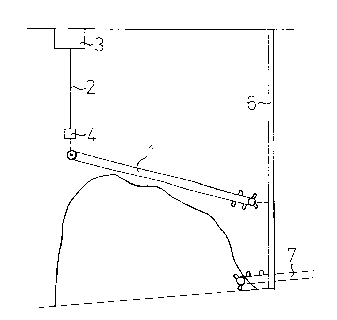Some of the information on this Web page has been provided by external sources. The Government of Canada is not responsible for the accuracy, reliability or currency of the information supplied by external sources. Users wishing to rely upon this information should consult directly with the source of the information. Content provided by external sources is not subject to official languages, privacy and accessibility requirements.
Any discrepancies in the text and image of the Claims and Abstract are due to differing posting times. Text of the Claims and Abstract are posted:
| (12) Patent Application: | (11) CA 2164192 |
|---|---|
| (54) English Title: | EQUIPMENT FOR TRANSFER OF BULK MATERIAL |
| (54) French Title: | EQUIPEMENT SERVANT A TRANSFERER DES MATERIAUX EN VRAC |
| Status: | Deemed Abandoned and Beyond the Period of Reinstatement - Pending Response to Notice of Disregarded Communication |
| (51) International Patent Classification (IPC): |
|
|---|---|
| (72) Inventors : |
|
| (73) Owners : |
|
| (71) Applicants : | |
| (74) Agent: | MCCARTHY TETRAULT LLP |
| (74) Associate agent: | |
| (45) Issued: | |
| (86) PCT Filing Date: | 1994-05-25 |
| (87) Open to Public Inspection: | 1994-12-08 |
| Examination requested: | 2001-03-23 |
| Availability of licence: | N/A |
| Dedicated to the Public: | N/A |
| (25) Language of filing: | English |
| Patent Cooperation Treaty (PCT): | Yes |
|---|---|
| (86) PCT Filing Number: | PCT/FI1994/000209 |
| (87) International Publication Number: | WO 1994027898 |
| (85) National Entry: | 1995-11-30 |
| (30) Application Priority Data: | ||||||
|---|---|---|---|---|---|---|
|
The invention relates to an appara-
tus for transferring loose material such as
peat, wood chips, coal and the like to fur-
ther processing. The said equipment is
comprised of a conveyor (1), a suspend-
ing element (2) for the conveyor, an el-
ement monitoring the suspension load (4),
and advantageously an element monitoring
the vertical deflection of the suspending el-
ement in the direction of the horizontal dis-
placement of the conveyor. The element
monitoring the suspension load (4) con-
trols the raising and lowering device (3)
connected to the suspending element (2)
in order to maintain the suspension load
of the conveyor (1) at a set value advanta-
geous for the efficiency of discharging.
L'invention concerne un appareil permettant le transfert de matières en vrac telles que de la tourbe, des copeaux de bois, du charbon et l'équivalent destinés à subir un traitement supplémentaire. Ledit équipement est doté d'un convoyeur (1), d'un élément suspendu (2) pour le convoyeur (1), d'un élément de contrôle de la charge suspendue (4) et d'un élément de contrôle de la déflexion verticale de l'élément suspendu dans le sens de déplacement horizontal du convoyeur. L'élément contrôlant la charge de suspension (4) commande le dispositif de levage et d'abaissement (3) relié à l'élément suspendu (2) de manière à maintenir la charge de suspension du convoyeur (1) à une valeur prédéterminée avantageuse pour l'efficacité du déchargement.
Note: Claims are shown in the official language in which they were submitted.
Note: Descriptions are shown in the official language in which they were submitted.

2024-08-01:As part of the Next Generation Patents (NGP) transition, the Canadian Patents Database (CPD) now contains a more detailed Event History, which replicates the Event Log of our new back-office solution.
Please note that "Inactive:" events refers to events no longer in use in our new back-office solution.
For a clearer understanding of the status of the application/patent presented on this page, the site Disclaimer , as well as the definitions for Patent , Event History , Maintenance Fee and Payment History should be consulted.
| Description | Date |
|---|---|
| Inactive: IPC from MCD | 2006-03-12 |
| Application Not Reinstated by Deadline | 2005-09-12 |
| Inactive: Dead - No reply to s.30(2) Rules requisition | 2005-09-12 |
| Deemed Abandoned - Failure to Respond to Maintenance Fee Notice | 2005-05-25 |
| Inactive: Abandoned - No reply to s.30(2) Rules requisition | 2004-09-13 |
| Inactive: S.30(2) Rules - Examiner requisition | 2004-03-12 |
| Amendment Received - Voluntary Amendment | 2001-06-20 |
| Letter Sent | 2001-04-10 |
| Inactive: Status info is complete as of Log entry date | 2001-04-10 |
| Inactive: Application prosecuted on TS as of Log entry date | 2001-04-10 |
| Request for Examination Requirements Determined Compliant | 2001-03-23 |
| All Requirements for Examination Determined Compliant | 2001-03-23 |
| Application Published (Open to Public Inspection) | 1994-12-08 |
| Abandonment Date | Reason | Reinstatement Date |
|---|---|---|
| 2005-05-25 |
The last payment was received on
Note : If the full payment has not been received on or before the date indicated, a further fee may be required which may be one of the following
Please refer to the CIPO Patent Fees web page to see all current fee amounts.
| Fee Type | Anniversary Year | Due Date | Paid Date |
|---|---|---|---|
| MF (application, 4th anniv.) - small | 04 | 1998-05-25 | 1998-05-08 |
| MF (application, 5th anniv.) - small | 05 | 1999-05-25 | 1999-05-12 |
| MF (application, 6th anniv.) - small | 06 | 2000-05-25 | 2000-03-28 |
| Request for examination - small | 2001-03-23 | ||
| MF (application, 7th anniv.) - small | 07 | 2001-05-25 | 2001-05-01 |
| MF (application, 8th anniv.) - small | 08 | 2002-05-27 | 2002-03-25 |
| MF (application, 9th anniv.) - small | 09 | 2003-05-26 | 2003-03-31 |
| MF (application, 10th anniv.) - small | 10 | 2004-05-25 | 2004-04-13 |
| MF (application, 2nd anniv.) - small | 02 | 1996-05-27 |
Note: Records showing the ownership history in alphabetical order.
| Current Owners on Record |
|---|
| JORMA MUSTAKOSKI |
| Past Owners on Record |
|---|
| None |